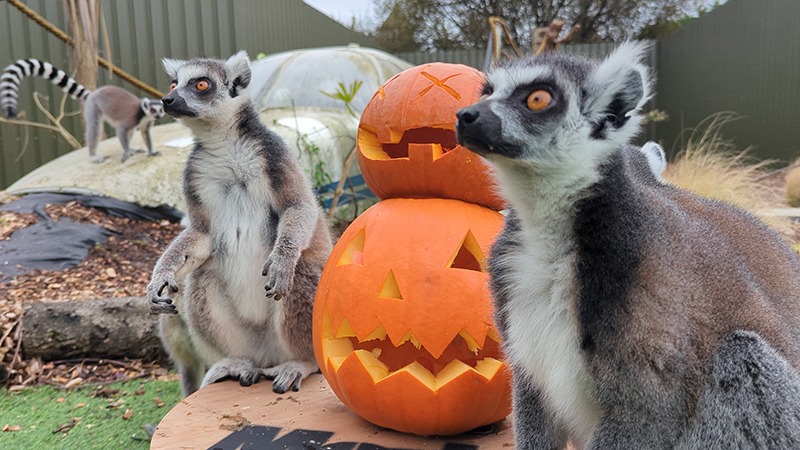Halloween came early for a troop of ring-tailed lemurs at Knockhatch Adventure Park in East Sussex as they were treated to a spooky surprise—carved pumpkins filled with tasty treats. The lemurs, including two sets of infant twins, explored and played with the pumpkins, an enrichment activity aimed at mimicking their natural foraging behaviours while enhancing their well-being.
The lemurs were introduced to the pumpkins as part of an initiative to provide new experiences for the endangered primates. The pumpkins, strategically carved to engage the animals, offered the lemurs a chance to find food in a novel and interactive way, giving visitors a rare chance to see the animals’ natural instincts in action. For their morning feed, one of the pumpkins was filled with sweet potato, a favourite snack among the troop, prompting the animals to reach inside and forage as they would in the wild.
Alana Lay-Flurrie, the zoo’s supervisor, watched as the lemurs approached the pumpkins, capturing the special interaction on camera. “These would have been the first pumpkins they’ve ever encountered!” Lay-Flurrie commented. She explained that the adult lemurs were especially curious, while the young infants, still nursing on their mother’s milk, showed interest but did not eat the treats. “The infants are very inquisitive, but they’re still reliant on their mothers and haven’t started eating solid food yet,” she added.
This activity not only offered entertainment for the lemurs but also served as a form of enrichment, encouraging behaviours essential to their mental stimulation and well-being. Ring-tailed lemurs, like those at Knockhatch, are critically endangered, with wild populations facing threats from habitat destruction and hunting. Conservationists view activities like these as crucial in helping captive lemurs express their natural behaviours and promoting their health and development.
Lay-Flurrie further explained that ring-tailed lemurs generally begin their reproductive lives at three years of age. They usually produce one offspring per year, although twins, like those seen in the current troop, are an occasional occurrence. After birth, the babies cling to their mothers for six months, eventually weaning and gaining independence.
The park’s initiative aligns with broader conservation efforts to protect the ring-tailed lemur population, which has been declining sharply in the wild. Every birth in captivity helps support the future of these intelligent and social primates, known for their distinctive black-and-white-striped tails and vibrant social dynamics. For visitors, it was an opportunity to learn more about the animals’ natural behaviours and challenges while enjoying a seasonal treat.
“This kind of enrichment allows our lemurs to explore their surroundings in a way that stimulates their minds and keeps them active,” said Lay-Flurrie. “Seeing them enjoy the pumpkins is not just fun for them, but it also raises awareness of the unique behaviours and conservation needs of these animals.”
The zoo plans to continue using themed enrichment activities throughout the year, particularly for special occasions like Halloween, aiming to offer both the animals and visitors an engaging and educational experience.


